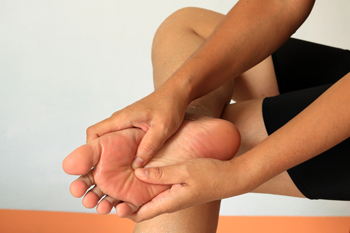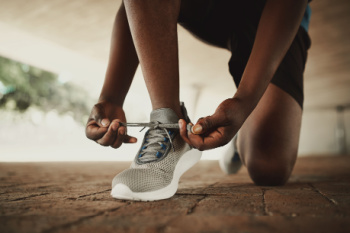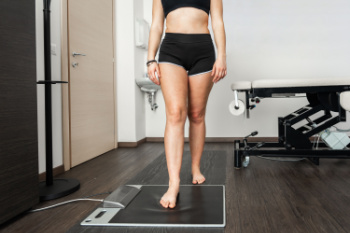Connect With Us
Blog

Peripheral neuropathy presents a diverse range of conditions that affect peripheral nerves in the lower extremities, resulting in symptoms like numbness and weakness. Causes can include diabetes, infections, injuries, or toxin exposure, with certain individuals at a higher risk due to genetics or lifestyle factors. Diagnosis involves a thorough assessment of symptoms and medical history, often supplemented by nerve conduction studies or imaging tests. Treatment focuses on symptom management and addressing underlying causes, taking certain medications, and making lifestyle adjustments, However, outcomes vary depending on the specific condition and its severity. If you suffer from peripheral neuropathy, it is suggested that you consult a podiatrist for an accurate diagnosis and personalized treatment plan.
Neuropathy
Neuropathy can be a potentially serious condition, especially if it is left undiagnosed. If you have any concerns that you may be experiencing nerve loss in your feet, consult with one of our podiatrists from Foot Surgery Specialists of Texas. Our doctors will assess your condition and provide you with quality foot and ankle treatment for neuropathy.
What Is Neuropathy?
Neuropathy is a condition that leads to damage to the nerves in the body. Peripheral neuropathy, or neuropathy that affects your peripheral nervous system, usually occurs in the feet. Neuropathy can be triggered by a number of different causes. Such causes include diabetes, infections, cancers, disorders, and toxic substances.
Symptoms of Neuropathy Include:
- Numbness
- Sensation loss
- Prickling and tingling sensations
- Throbbing, freezing, burning pains
- Muscle weakness
Those with diabetes are at serious risk due to being unable to feel an ulcer on their feet. Diabetics usually also suffer from poor blood circulation. This can lead to the wound not healing, infections occurring, and the limb may have to be amputated.
Treatment
To treat neuropathy in the foot, podiatrists will first diagnose the cause of the neuropathy. Figuring out the underlying cause of the neuropathy will allow the podiatrist to prescribe the best treatment, whether it be caused by diabetes, toxic substance exposure, infection, etc. If the nerve has not died, then it’s possible that sensation may be able to return to the foot.
Pain medication may be issued for pain. Electrical nerve stimulation can be used to stimulate nerves. If the neuropathy is caused from pressure on the nerves, then surgery may be necessary.
If you have any questions, please feel free to contact our offices located in River Oaks and Sharpstown in Houston, TX . We offer the newest diagnostic and treatment technologies for all your foot care needs.

Choosing well-fitting shoes is vital for foot health. To ensure proper fit, match the shoe to the outline of your foot, considering both length and width. Your shoes should accommodate the natural shape of your foot without squeezing or causing pressure points. Look for shoes with adequate toe room, a snug heel fit, and ample width across the ball of the foot. Additionally, opt for breathable materials and cushioned soles to enhance comfort and reduce friction. Avoid shoes that require a break-in period or feel tight, as they can lead to blisters and discomfort. If you are in the market for new shoes, it is suggested that you schedule an appointment with a podiatrist who can provide valuable guidance in selecting suitable footwear, especially for individuals with specific foot conditions or structural abnormalities. Podiatrists can assess your foot shape and biomechanics, offer personalized recommendations and provide customized orthotics or modifications to improve shoe fit and alleviate foot pain or discomfort.
It is important to find shoes that fit you properly in order to avoid a variety of different foot problems. For more information about treatment, contact one of our podiatrists from Foot Surgery Specialists of Texas. Our doctors will treat your foot and ankle needs.
Proper Shoe Fitting
Shoes have many different functions. They cushion our body weight, protect our feet, and allow us to safely play sports. You should always make sure that the shoes you wear fit you properly in order to avoid injuries and deformities such as: bunions, corns, calluses, hammertoes, plantar fasciitis, stress fractures, and more. It is important to note that although a certain pair of shoes might be a great fit for someone else, that doesn’t mean they will be a great fit for you. This is why you should always try on shoes before buying them to make sure they are worth the investment. Typically, shoes need to be replaced ever six months to one year of regular use.
Tips for Proper Shoe Fitting
- Select a shoe that is shaped like your foot
- Don’t buy shoes that fit too tight, expecting them to stretch to fit
- Make sure there is enough space (3/8” to ½”) for your longest toe at the end of each shoe when you are standing up
- Walk in the shoes to make sure they fit and feel right
- Don’t select shoes by the size marked inside the shoe, but by how the shoe fits your foot
The shoes you buy should always feel as good as they look. Shoes that fit properly will last longer, feel better, and improve your way of life each day.
If you have any questions, please feel free to contact our offices located in River Oaks and Sharpstown in Houston, TX . We offer the newest diagnostic and treatment technologies for all your foot care needs.

Foot assessment is a fundamental tool in classifying foot types and identifying potential problems. By analyzing the position of the foot at rest and during dynamic movement, podiatrists can infer dynamic foot function and identify abnormalities. Radiologic evaluations serve as the gold standard for assessing foot structure and alignment, providing detailed insight into bone structure and joint alignment. Podiatrists assess feet and conduct thorough evaluations, interpret radiographic findings, and develop tailored treatment plans. Through a combination of physical examination, gait analysis, and imaging techniques, podiatrists can identify conditions such as flat feet, high arches, bunions, and stress fractures, among others. If you would like to understand how your foot structure may be causing your foot problems, it is suggested that you schedule an appointment with this foot doctor for a consultation.
If you have any concerns about your feet, contact one of our podiatrists from Foot Surgery Specialists of Texas. Our doctors can provide the care you need to keep you pain-free and on your feet.
Biomechanics in Podiatry
Podiatric biomechanics is a particular sector of specialty podiatry with licensed practitioners who are trained to diagnose and treat conditions affecting the foot, ankle and lower leg. Biomechanics deals with the forces that act against the body, causing an interference with the biological structures. It focuses on the movement of the ankle, the foot and the forces that interact with them.
A History of Biomechanics
- Biomechanics dates back to the BC era in Egypt where evidence of professional foot care has been recorded.
- In 1974, biomechanics gained a higher profile from the studies of Merton Root, who claimed that by changing or controlling the forces between the ankle and the foot, corrections or conditions could be implemented to gain strength and coordination in the area.
Modern technological improvements are based on past theories and therapeutic processes that provide a better understanding of podiatric concepts for biomechanics. Computers can provide accurate information about the forces and patterns of the feet and lower legs.
Understanding biomechanics of the feet can help improve and eliminate pain, stopping further stress to the foot.
If you have any questions please feel free to contact our offices located in River Oaks and Sharpstown in Houston, TX . We offer the newest diagnostic and treatment technologies for all your foot and ankle needs.
Blog Archives
- May 2024
- April 2024
- March 2024
- February 2024
- January 2024
- December 2023
- November 2023
- October 2023
- September 2023
- August 2023
- July 2023
- June 2023
- May 2023
- April 2023
- March 2023
- February 2023
- January 2023
- December 2022
- November 2022
- October 2022
- September 2022
- August 2022
- July 2022
- June 2022
- May 2022
- April 2022
- March 2022
- February 2022
- January 2022
- December 2021
- November 2021
- October 2021
- September 2021
- August 2021
- July 2021
- June 2021
- May 2021
- April 2021
- March 2021
- February 2021
- January 2021
- December 2020
- November 2020
- October 2020
- September 2020
- August 2020
- July 2020
- June 2020
- May 2020
- April 2020
- March 2020
- February 2020
- January 2020
- December 2019
- November 2019
- October 2019

